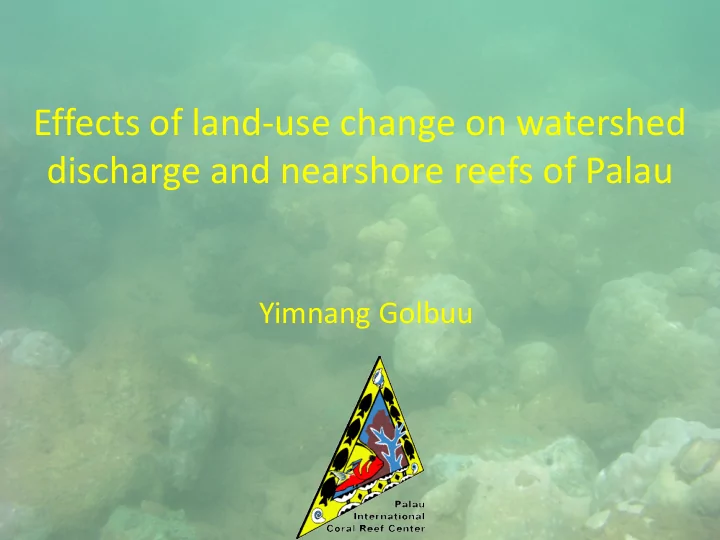

Effects of land-use change on watershed discharge and nearshore reefs of Palau Yimnang Golbuu
Increase in sedimentation is a major Issue facing coral reef worldwide because of poor land-use practices In Palau and many other Pacific Islands, it is a major problem land-use change steep topography highly erodible volcanic soil high rainfall
1. Numerous studies on impacts of increased sedimentation 2. Few looking at an ecosystem scale 3. Babeldoab allows quantification and analysis of watersheds with varying level of land-use
Questions 1. How can differences in land-use and land development be quantified? 2. What is the explicit relationship between land development in the four watersheds and their river sediment yield 3. What is the relationship between river sediment flux and sedimentation rate
Methods Physical Data YSI Self-logging nephelometers Turbidity Temperature Salinity
Sedimentation
Diongradid 49.2 tons/km2/year 20.6 km 2 215.7 tons/km2/year Ngermeduu 86.3 km 2 9.7 tons/km2/year Ngerdorch 47.4 km 2 462.4 tons/km2/year Ngerikiil 28.5 km 2
Results 1. Earth Moving Permits were used to quantify level of development 2. Strong relationship between Earth Moving Permit and river sediment yield (R 2 =0.96, p=0.02) 3. Sedimentation rate affected by both development and geomorphology and hydrodynamics
Coral Reef Communities = Chemical + Physical + Biological Difficult to assess the relative contribution of each specific attribute
Three Approaches 1. Sites at the end points of a known environmental gradient 2. Sites along a known environmental gradient 3. Coral transplantation
In this study we combine the second and third approaches. We measured the physical environmental conditions and biological parameters along a gradient We used coral transplant manipulations to determine the relationship between the physical environmental and coral growth and mortality rates.
Objective To assess the effects of watershed discharge on coral community structure by examining relationships between the environmental variables and the biological parameters.
Ngermeduu Watershed biggest in Palau 86.3 km 2 Sediment Yield: 2 nd highest in Palau 216 ton km -2 year -1
Benthic Surveys Coral cover and richness Juvenile density and richness
Study Design
Results
Coral cover increased by 7% for every km away from the mouth of the bay Density of juvenile coral increased by 3.2 m -2 for every km away from the mouth of the bay
Linear Regression Models p-level Slope ± s.e. F Multiple R 2 <0.001 -2.6 ± 0.6 (a) Coral cover SSC (mean) 0.34 22.1 -0.53 ± 0.07 (b) Coral diversity 0.54 51.2 <0.001 Sedimentation (terrestrial) -0.49 ± 0.11 (c) Density of juvenile 0.33 21.2 <0.001 Sedimentation corals (terrestrial) -0.41 ± 0.07 0.47 38.4 <0.001 (d) Diversity of juvenile Sedimentation corals (terrestrial)
Transplants Mortality of AD higher than PC (11% vs 4%) No site nor size difference in survival rates No significant difference in growth rate among five sites
Discussion Terrestrial sedimentation strongly govern juvenile density and composition Acropora showed higher mortality than Porites , but no difference due to size or location, yet very clear difference in juvenile and adult coral communities among the sites. Post-settlement mortality important near the rivers driving the difference in coral community composition Coral cover not as powerful as coral diversity as an indicator of stress
Management Implications Together, these results show that sedimentation and turbidity exert strong influence on nearshore reefs reducing their diversity Important implications for reefs of Palau and all reef systems downstream of rivers Land development very often leads to increase in river runoff and SSC that reduce coral cover and diversity on adjacent reefs Increase in terrestrial discharge need to be controlled and mitigation procedures put in place to ensure that these nearshore reefs continue to support diverse and productive systems as they have for the past 1,000 years
Support land-use planning, particularly for Babeldaob Evaluate and strengthen current regulations to control erosion and runoff Support continued monitoring of nearshore reefs Adapt ecosystem approach to marine conservation
Acknowledgements NOAA Coastal Oceans Program NOAA Coral Reef Conservation Program David and Lucille Packard Foundation through Palau EBM Initiative Palau Conservation Society Tiare Holm, Umai Basilius and Palau EBM Core Group Arius Merep, Geory Mereb, Dawnette Olsudong, Irving Dwight, Jay Andrew
Recommend
More recommend